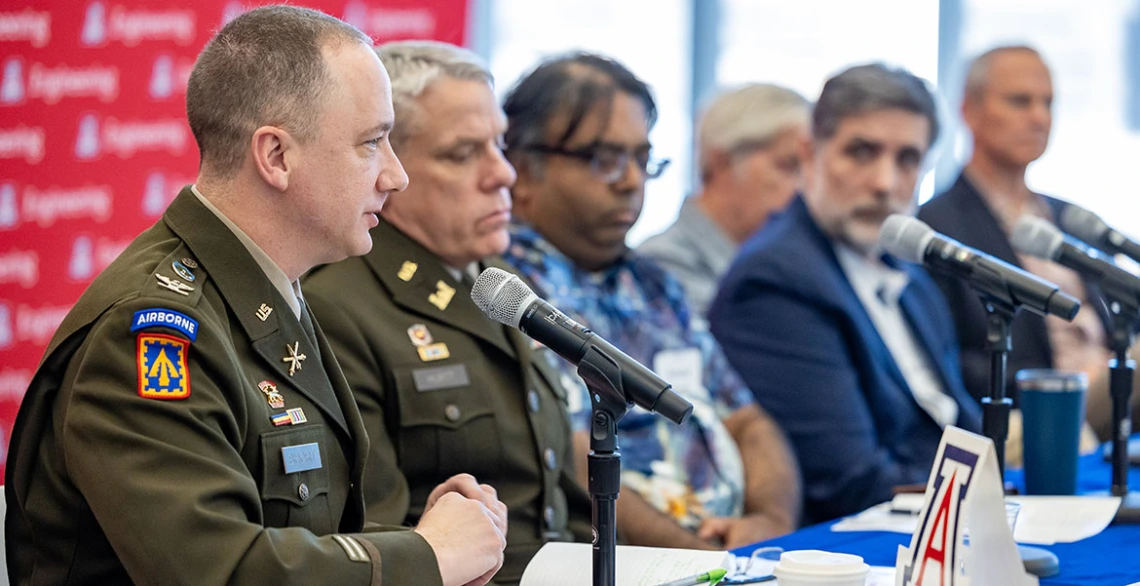Near Space Symposium Strengthens Ties Between University, Industry and Government
The new Institute for Near Space Studies is exploring a land of opportunities that begins 60,0000 feet up.

Panelists – from left to right: Col. David Short, U.S. Northern Command; Col. Erikk Hurtt, U.S. Army Space & Missile Defense; aerospace and mechanical engineering associate professor Jekan Thanga; systems and industrial engineering professor Roberto Furfaro; astronomy professor Chris Walker; and Maj. Gen. Charles Corcoran, U.S. Air Force (retired) – discuss near space balloons and sensors.
The College of Engineering and its near space partner, Missile Defense Advocacy Alliance, co-hosted the Near Space Symposium on April 19. David W. Hahn, the Craig M. Berge Dean of the college, and MDAA Founder Riki Ellison welcomed representatives from the University of Arizona, U.S. military and defense industry.
“This symposium came together around a shared vision and a broad set of complementary interests. We’re here today to focus on opportunities in near space,” said Hahn.
Balloons, airships and a few planes can reach near space – generally defined as from 60,000 feet to 300,000 feet above Earth – providing a unique environment for technology development.
The college and MDAA established the Institute for Near Space Studies in October 2023 to bolster the university’s near space and hypersonic research as well as serve students in academic programs and conduct STEM outreach.
“We will create an academic environment where we can share and create a culture of trust,” said Ellison.
The symposium’s open forums covered defense technologies in near space – balloons, sensors, missiles and threat mitigation systems – advanced communication capabilities, and policy considerations.
Space for Ingenuity
Near space poses distinctive defense concerns, said Mark Montgomery, senior director of the Center on Cyber and Technology Innovation, part of a nonprofit research institute focusing on national security and foreign policy.
“When you look at the threats, there is so much battle space to defend in America, it becomes overwhelming,” he explained. “If you did it through traditional systems, the cost could be $100 billion.”
However, employing emerging technologies in near space can more cost-effectively ensure our nation’s security, he said. For example, aerostats – lighter-than-air, gas-filled aircraft similar to blimps – can be outfitted with radar to detect farther than ground-based systems can track.
“A handful of these aerostats could observe all the approaches to the U.S.,” said Montgomery. “We should see near space as a technical opportunity.”
Near space also improves communication capabilities. Electrical and computer engineering professor Hao Xin, an expert in high frequency technologies, provided an example: “An advanced antenna system in near space can transmit in every direction because the ground isn’t there to block.”
Additionally, near space eliminates challenges of communicating across oceans, said Saikat Guha, Nasser Peyghambarian Endowed Chair in Optical Sciences, who specializes in optical and quantum technologies.
“I want us to dream big, in the state of Arizona, to lead the world and lead our nation on near space. Nobody's doing it at this level. It's about being at the right place at the right time for the right reasons with the right people,” said Ellison.
Ongoing Education
Through the Institute for Near Space Studies, MDAA expanded its Youth Impact Program to the UA. The leadership development program will take place in June and provide a positive, fun learning environment for middle school students, with a plan to incorporate balloons with instrumentation payloads into the program this year in collaboration with the College of Engineering.
Beginning with the fall semester, the institute will offer the Arizona AETOS Executive Program. The engineering certificate program will educate aspiring technical leaders from the military, government, and technological communities about the near space domain.
“The near space realm is important, and will only become more so,” said Hahn. “The college is fortunate to have valuable partnerships with MDAA, as well as all who joined us at the symposium. By continuing to pool our knowledge and capabilities, we will capitalize on all near space can offer.”



